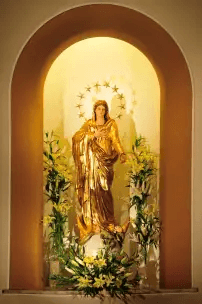Our Immaculate Mother
LAUDETUR JESUS CHRISTUS ET MARIA IMMACULATA

(Our Devotion to Mary)
When was the last time you heard this ejaculatory prayer, this family greeting in an Oblate community? Where has it gone, this old, almost two hundred year-old tradition of using L.J.C. et M. I. at the conclusion of a series of exercises of piety or of community meetings? Why have we practically abandoned the custom of using this Christological-Marian prayer which was a distinguishing mark for the Congregation and which would often be found on the lips of an Oblate of Mary Immaculate in the course of a day?
In the first volume of his work Méditations pour tous les jours de l’année. Father Boisramé dedicated meditation XIX to this Oblate greeting. Here are a few lines of what he wrote: “In principle, the Patriarch of the Oblates used to begin his letters with L.J.C. Later on, about the time when our Institute received the glorious title with which Leo XII graced it, he added, et M.I. Amen. Laudetur Jesus Christus et Maria Immaculata. Amen. There you have the greeting in use throughout the whole family. Meditate upon it so that it does not remain an empty phrase. It follows that Jesus Christ and Mary Immaculate are the inexhaustible subject of our praise, our admiration and our love.” [1]
And as resolutions flowing from this meditation, Father Boisramé suggested:
To maintain the blessed habit of beginning whatever you write with L.J.C. et M.I.;
To piously greet in this manner all those with whom you live in those places where this custom exists;
Today, to begin and end all exercises done in private by these same words which will serve as a spiritual bouquet: Laudetur Jesus Christus et Maria Immaculata. Amen! [2]
The passages quoted were written in 1887, but we must recognize that the Founder had already begun the practice of using the greeting Laudetur Jesus Christus at the seminary of Saint Sulpice where it was commonly practiced. In addition to that, a similar expression Laudetur Jesus et Maria was a traditional practice among the Redemptorists at the time of our Founder.
In his circular letter of March 19, 1865, Father Joseph Fabre quoted:
from an October 9, 1815 letter of Abbé de Mazenod written at Aix.
from an October 27, 1815 letter in response to Abbé Henry Tempier in Arles,
from two letters of Abbé de Mazenod written at Aix, November 15 and December 13, 1815;
from Abbé Tempier’s response written at Arles, December 20, 1815. [3]
All these letters from Abbé de Mazenod and Abbé Tempier bear at the upper left-hand corner of the first page the invocation L.J.C.
The Missions volume of 1872 is telling with regard to this subject in its pages entitled, Voyage à Rome du Révérendissime Père Charles Joseph-Eugène de Mazenod, fondateur et premier supérieur général de la Congrégation des Oblats de Marie Immaculée (1825-1826). [4] This narrative is made up of a series of twenty-six letters written by Father de Mazenod from November 1, 1825 to March 16, 1826: one to Father Hippolyte Courtès, one to Bishop Fortuné de Mazenod and twenty-four to Father Tempier. All of these letters are headed by the invocation L.J.C. A twenty-seventh letter from Rome addressed to Father Tempier and dated March 20, bears for the first time the formula L.J.C. et M. I. All the other letters which follow during this trip, numbers 27 to 40, bear the invocation L.J.C. et M.I.
But let us come back to the letter the Founder wrote Father Tempier from Rome, on March 20, 1826, and let us quote a few lines in order to savor all his ardor on the occasion of our name being approved as Oblates of Mary Immaculate. That is without any doubt why he immediately added et Maria Immaculata to the invocation L.J.C. so long used at the top of the page of all his correspondence.
“May we understand well what we are! I hope that the Lord will give us this grace with the assistance and by the protection of our holy Mother, the Immaculate Mary, for whom we must have a great devotion in our Congregation. Does it not seem to you that it is a sign of predestination to bear the name of Oblates of Mary, that is, consecrated to God under the patronage of Mary, a name the Congregation bears as a family name held in common with the most holy and immaculate Mother of God? It is enough to make others jealous; but it is the Church who has given us this beautiful name, we receive it with respect, love and gratitude, proud of our dignity and of the rights that it gives us to the protection of her who is All Powerful in God’s presence.” [5]

There can be no doubt that, following the approbation of the Congregation under the title Oblates of Mary Immaculate in 1826, it was the Founder’s explicit will that the greeting Laudetur Jesus Christus et Maria Immaculata should become a part of the family treasures. He often stressed using the invocation by pointing out that people had forgotten to use it. For example, in a letter to Father Charles Bellon, he added a brief observation as a postscript: “P.S.: You forgot to start your letter with L.J.C. [and] M.I.” [6] And a little later, on August 15, 1846, he wrote to the superior of the community in Ajaccio in the following words: “Uniformity in our customs is something I am keen about, and rightly so: that ofwriting at the top of their letters the invocation in honor of our Lord Jesus Christ and his most holy Immaculate Mother has been adopted from the beginning. We must, therefore, make it a habit and see it as being important that others will obey.” [7]
In his book on the spirit and virtues of the Founder, Father Eugène Baffie once again confirms for us the custom of our family greeting. Here is what he wrote: “At the beginning of his endeavor, not yet having foreseen the name it would bear in the Church, without even hoping that it would ever bear any name, Father de Mazenod used to see to it that all public exercises, either in the chapel in Aix or during parish missions, should conclude with this blessed acclamation three times repeated by the people present: “May Jesus Christ be eternally praised and may Mary always Immaculate with her divine Son be likewise praised.” This acclamation from the crowds in honor of the Immaculate Conception was too pleasing to the Heart of Jesus for it not to draw down on the missionaries who instigated it the most abundant of blessings […] In any case, these humble priests of the poor enjoyed greeting each other during the day with this exclamation springing from their hearts in honor of their Immaculate Mother: Praised be Jesus Christ and Mary Immaculate. When recreation time arrived, they used this as a signal to break their silence and launch into their edifying conversations.” [8]
Devotion to Mary Immaculate is very deeply rooted in the Congregation and our invocation L.J.C. et M.I. is merely one of its manifestations. Confraternities grew numerous; the scapular of the Immaculate Conception was introduced with solemn ceremony; Marian preachers abounded.
In his Mélanges historiques, Bishop Jacques Jeancard wrote a delightful paragraph on the topic of Bishop de Mazenod’s attitude towards the Immaculate Conception: “Then, when the time preordained by God had arrived, the name of Mary Immaculate was inscribed on the foreheads of the Oblates just as it is engraved in their hearts, Providence brought their father to the attention of Pius IX who by a special mark of honor invited him to come to participate in the glorification of that same name while the holy pontiff was preparing to make it shine forth before the whole Church like a ray of light affixed to the crown of the Mother of God. As bishop and as Superior General of the Oblates, Bishop de Mazenod was keenly conscious of the favor bestowed upon him. He left for Rome his heart filled with a holy joy.” [9]
Consequently, the use of our family greeting L.J.C. et M.I. has been from the very beginnings of our Institute a sign or a manifestation of our life with Mary. “Sentire cum Maria.” As was so aptly stated by Father Leo Deschâtelets in his letter on “Our Vocation and Life of Intimate Union with Mary Immaculate”: “If we want to understand our vocation, this is not a case of having an ordinary devotion to Mary Immaculate. It is rather a kind of identification with Mary Immaculate; it is a case of giving ourselves to God through her and with her which reaches to the very depths of our life as Christians, religious, missionaries and priests.” [10]
Yes, “we are the Oblates of Mary Immaculate in the strictest sense of the word. It is through her that we will be Oblates in our souls, Oblates of Jesus Christ, Oblates of the divine charity.” [11] So let us take all the means necessary of expressing to our Immaculate Mother in whom we possess the most refined manifestation of divine Love, an “uncommon devotion”, the love of real sons and the surrender of children amenable to their mother’s wishes.
Our family greeting Laudetur Jesus Christus et Maria Immaculata can certainly help us to awaken or simply to rekindle in each one of us this Marian devotion to the Immaculate, the Virgin who is the bridge leading to God because she is the creature who mediates God to us. Can we allow this noble tradition of our Oblate history to lapse or should we not pull ourselves together again and breath new life into it?
“If only you would listen to him today, do not harden your hearts…” (Psalm 95)
GASTON J. MONTMIGNY
Notes
[1] BOISRAME, Prosper, Méditations pour tous les jours de l’année, Tours, Mame and Sons, 1887.
[2] Ibidem, p. 81.
[3] Circular letter no. 15 in Circ. adm., I, p. 131 ff.
[4] Missions, 10 (1872), p. 153 ff.
[5] Ibidem, p. 277; in Oblate Writings I, vol. 7, no. 231, p. 63.
[6] July 10, 1844 letter in Oblate Writings I, vol. 10, no. 846, p. 74.
[7] In YENVEUX, Alfred, Les Saintes Règles, vol. VI, p. 53; also, COSENTINO, George, “Notre salutation de famille”, in Etudes oblates, 22 (1963), p. 443.
[8] BAFFIE, Eugene, Esprit et vertus du missionnaire des pauvres C. J. Eugène de Mazenod, évêque de Marseille, fondateur de la Congrégation des Missionnaires de Marie Immaculée, Paris-Lyon, Delhomme and Briguet, 1894, p. 203-204.
[9] Mélanges historiques sur la Congrégation des Oblats de Marie Immaculée, Tours, 1872, p. 271.
[10] Circular letter no. 191, August 15, 1951 in Circ. adm., V (1947-1952), p. 348 (51).
[11] Ibidem, p. 347 (50).
